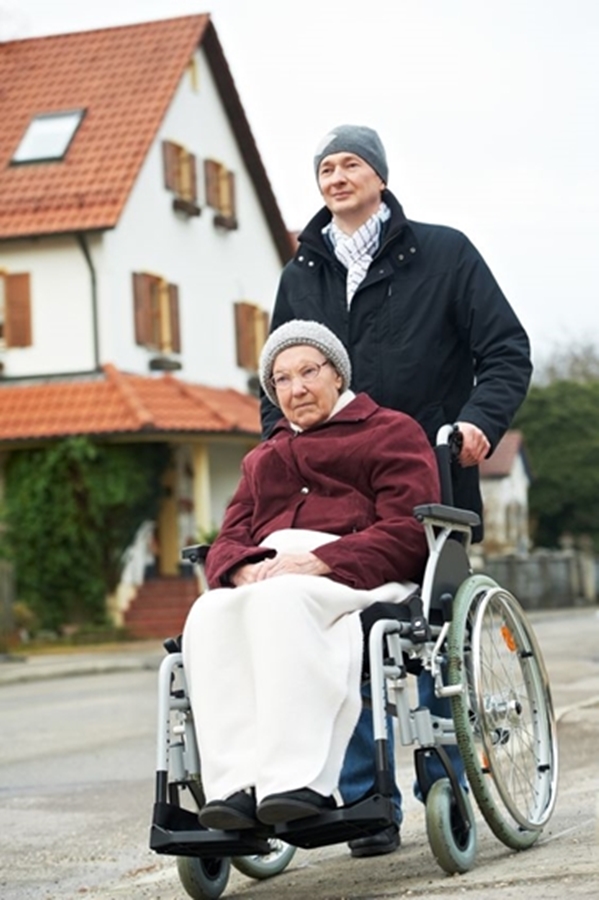Personally, I have never been good at exercising. I hate it. I might feel much better if I stayed with it for a while, but I’m so out of shape that I feel awful doing it. Not so for Lynn. He has always been good about doing some type of exercise almost every day. The major difference now is that I have to help him with it. Therefore, one of my many roles in caring for Lynn is to be his personal physical therapist.
For anyone, but especially those with conditions that produce fatigue, keeping conditioned is essential to conserving energy. If the muscles don’t work efficiently, it takes a lot more energy to do the simple tasks of everyday life. Lack of stimulation to the muscle groups causes them to become de-conditioned, which requires more oxygen and other support from the body to make them work correctly. When Lynn was in the hospital so much in 2010, he was told that for every day of inactivity (i.e., being confined to bed) he experienced, it would take approximately a week to regain what was lost due to deconditioning. He found that to be true to a large extent. It has taken him years to build back up much of the strength he lost during those three hospitalizations, and some of it has never returned to the same level.
There is not a whole lot you can do to prevent the progression of MS; however, if you keep fit, you’re more likely to maintain greater strength and endurance than if you are out of shape. Lynn does not want to give up and let me do everything for him. He wants some control over his condition, so exercising is both a mental triumph and a physical one. Here’s some of what he does.
Diaphragm strengthening – when he first got out of the hospital, he could not say an entire sentence without taking a few gasps of breath in the process. He used to sing tenor and could control his breathing and extend notes for quite some time. He hopes to one day be able to sing again, but for now, he signs for exercise. Each morning, he does his vocal exercises. He has 4-5 songs in his voice range that he sings every day. He does this right after he gets up before his energy is depleted because controlled breathing takes a lot of energy to do well.
Arms – Lynn’s right arm and hand do very little independently. His left arm and hand are fairly strong, but he does have a little weakness in them, especially at the end of the day, but overall, they function well. To help maintain that strength and to build back up the right side, he has bought weights that I strap around his wrists. He then exercises the various muscle groups of the arm with the weights on and holding in his hand little one-pound weights. He also uses rubber tube bands for resistance exercises and has pull-down weights. At least once a week, he peddles a stationary foot peddler with his hands to use his grip and get good shoulder rotation going.
Legs- Like his upper body, his left side is stronger than his right. He uses an electric foot peddler all day to keep his circulation stimulated, providing some passive exercise. He has designed a leg press device that he can drive his wheelchair to, and I place his feet in a box that holds them in place while he pushes the weight of the device backward. We also bought a TRAM from Rifton, which he uses to stand upright and put weight on his legs. This allows him to tighten and relax those leg muscle groups necessary for standing and walking.
For balance, he instructed our son to take PVC pipe, cut it to certain specifications, and glue the pieces together so they could be assembled to serve as a cage around him. By surrounding him, he can hold on at several places on the device to do pushups and simply balance. He also does an exercise where he sits on the edge of the bed, leans in various directions to get off-balance, and then has to get upright again. Occasionally, he asks me to make it harder on him by pushing him slightly off balance.
He has two types of hand-strengthening devices, which he uses often as he sits and watches TV to strengthen his grip. He pushes his head against my hand to strengthen his neck. He points his toes up and down to keep his foot flexible, and I help him frequently extend his arm in various directions to help keep it flexible.
His dedication to exercising some part of his body daily has helped him regain some of his muscle strength and flexibility, but not nearly all. He still has a long way to go. It also takes a lot of my time to hook him up to these devices, monitor him as he’s doing them so he doesn’t get hurt, unhook him afterward, and store away the equipment. So you can see why I consider one of my roles to be his physical therapist.
What’s frustrating is that insurance doesn’t pay for in-home physical therapy to prevent de-conditioning. Insurance will pay if the physical therapy shows progress toward restoring function so that they can document some type of improvement in a person, but it doesn’t recognize the benefit of not letting the body become de-conditioned. Why isn’t it just as valuable to prevent someone from becoming so weak that he/she can no longer walk or become bedridden? There are significant complications that occur when that happens that are very costly. I think the insurance companies are being rather short-sighted, don’t you? If Congress wants healthcare reform, why doesn’t it address some of these preventive features? Oh well, don’t get me started on healthcare reform…
As a caregiver, I wear many hats, all of which are very important, and being Lynn’s physical therapy assistant is one of my most important roles. It’s very hard work because often, I’m required to hold dead weight for extended periods or hold my own body in awkward positions. It’s often very uncomfortable and takes me away from my job, which I do from home, preventing me from having time to do my own exercise program. (Well, maybe if I’m truthful, that might be just another excuse not to exercise) I realize, however, that I must start doing some exercise myself because I can’t help him as well if I don’t so today I bought myself some classic disco CDs (yes I’m showing my age) that I can dance to as I work in the kitchen. At least I’ll be moving, which may be the motivation I need to exercise myself.
This article originally appeared on Multiplesclerosis.Net by Health-Union, LLC, and has been reposted with permission.



